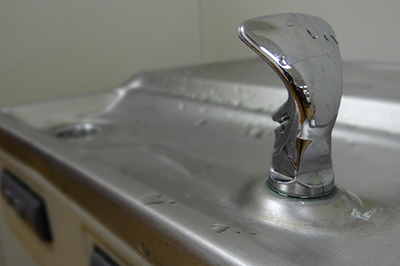Tag: Facilities Maintenance
Green Cleaning Step 2 Prepare Your School
EPA Publications about Indoor Air Quality in Schools
Publications from EPA on Indoor Air Quality
Walkthrough: Four Schools Making a Difference
Green Cleaning Step 1 Green Cleaning Starts Here
Indoor Air Quality: Ventilation Basics
Financing Healthy School Environments
EPA, 2016. Numerous sources of funding are available to create and support healthy, productive school environments for students and staff. The links on this page describe how to find a variety of funding sources, including grants, tax credits, loans and others.
Addressing Indoor Air Quality in School Energy Efficiency Upgrades: Review of Selected State Policies
Environmental Law Institute, 2016.
Energy efficiency continues to be an important component of federal, state, and local efforts to reduce greenhouse gas emissions. School facility upgrades that increase energy efficiency can help school districts advance their educational mission by reducing energy and other operating costs. Facility upgrades that protect and improve indoor air quality (IAQ) also support the core mission of schools by promoting staff and student health, productivity, and attendance. There is now broad recognition that it is possible to achieve both energy efficiency and indoor air quality goals as part of a school retrofit project. When undertaking energy efficiency and other facility upgrades, early consideration of IAQ issues can help schools avoid unintended, negative consequences and reap the twin benefits of energy savings and a healthier, more productive school environment.
State laws, regulations, and guidance can facilitate the integration of IAQ and energy efficiency goals. This report discusses three areas of potential policy development: state funding for school facility upgrades, energy savings performance contracting, and regulation of indoor pollutants during renovation. While these are not the only policy areas ripe for consideration, the examples described throughout the report reflect a variety of strategies for maximizing the health benefits of energy retrofits and other school facility upgrades.
State Funding for School Facility Upgrades
States operate a variety of programs that provide grants, loans, and other financing for school energy efficiency retrofits and other facility upgrades, and these programs are particularly important for school districts that have limited resources for capital-intensive measures. Currently there are few state funding programs that affirmatively require or encourage the integration of IAQ and energy goals, however the report highlights examples of policy strategies that have been adopted and could be expanded in the future. These include:
- Establishing energy-related IAQ improvements as allowable or priority uses of energy efficiency funding;
- Considering non-energy benefits, such as enhanced IAQ, in awarding energy-efficiency funding; and
- Establishing IAQ measures as priorities for general school renovation and repair programs.
Drinking Water Quality in Child Care Facilities: A Review of State Policy
Environmental Law Institute, 2015.
In January 2015, the Environmental Law Institute published Reducing Environmental Exposures in Child Care Facilities: A Review of State Policy. The report, prepared jointly by ELI and the Children’s Environmental Health Network, discusses state policies addressing exposure to indoor air contaminants in licensed child care facilities. This paper focuses on another important environmental health issue for child care facilities: drinking water quality.
A variety of national policies and program initiatives aim to ensure that children who spend time in child care facilities drink water throughout the day.1 Ensuring the quality of drinking water at child care facilities is important to children’s healthy development and helps advance the broad goals of early care and education programs. This paper provides an overview of how existing state laws and regulations across the United States address drinking water quality in the licensed child care context, with a particular emphasis on drinking water from private wells.
Kids Don’t Belong on Cleanup Crews
By Jerome A. Paulson, MD, FAAP
E. M. Wallace makes some very appropriate points about keeping schools clean in her recent blog post Dust, Droppings, and Desperation (February 18, 2016). Schools need to protect children and employees in and around the buildings, and cleaning the buildings is one of the cornerstone activities of that fiduciary responsibility.
I was disturbed by the basic story of that blog post, and I was also very disturbed by the involvement of young adults in the cleanup process. These individuals were workers in a hazardous site. “They were met with thick layers of dust, “filth”, heavy mold and mildew, scattered dead crickets, and vermin droppings…”(Wallace, 2016). The first question is whether it is ever appropriate for children or young adults to be asked to work in a hazardous site; the second question is if it is appropriate for them to be there, were they (whether they were children, adolescents or adults) afforded the necessary personal protective equipment and processes to work in a hazardous site?
The issue of young adults (and I would add children and adults to this consideration in many situations) volunteering for cleanups goes well beyond this example. Many volunteer groups took children into Louisiana and other states for post-Katrina cleanup, and many volunteer groups go into other areas post-disaster or to do a “spring cleaning” of a riverbank or similar area. Religious groups, scouting groups, community organizations and others undertake these activities (The Connection Newspapers, 2006; Lovewell, 2007).
Child or adolescent volunteers are still in the formative part of their lives when they are more vulnerable to environmental hazards than are adults (Cohen-Hubal, et al., 2014). At this point in their lives, their brain, lungs, endocrine system and other parts of the body are still developing; therefore, they are more vulnerable to chemical, physical and biological toxicants that they can encounter in their environment.
I don’t know, but I certainly suspect that in the situation referred to by Wallace (2016) neither the volunteers nor their parents (if the volunteers had not reached the age of majority) were informed in detail about the potential hazards to be encountered at this school. Did the individuals who organized this activity have any idea as to the hazards to be encountered? How could the worker-volunteers and their parents have given consent to participate in this activity if adequate and appropriate information was, presumably, not provided?
All workers in hazardous environments should be afforded appropriate personal protective equipment (PPE) and receive adequate instructions to use that equipment appropriately (OSHA, n.d.). They need to receive training for appropriate work practices to be used in a toxic environment. Moreover, toxic materials can hitch a ride to the workers’ home and family, on their hair, skin, clothing and shoes (Zirschky, 1996; Sattler, & Davis, 2008) unless workers have PPE which they put on before entering the site and remove before returning home. Workers need to be able to leave their shoes at the worksite unless the shoes were covered by the PPE. Workers also need the opportunity to wash before eating during lunch and breaks so that they do not ingest toxic materials with their food.
I am very concerned that individuals, particularly those involved in organizing these types of activities, get caught up in the do-good, feel-good aspects of the projects and how these types of activities "build character" and "teach compassion" and fulfill community service or religious goals. While all of that may be true, these same individuals do not consider the risks to which they are exposing themselves or their charges. Organizers have a responsibility not to put volunteers in harm’s way. This is particularly true for child and adolescent volunteers who may not have the judgment to remove themselves from the activity either because they don’t perceive the danger or are too concerned with “going against the flow” of what their friends and supervisors are doing. The organizers need to fully consider the potential risks of having volunteers, particularly children and adolescents, work in these settings as well as the benefits. I, for one, think that the risks, in some instances, outweigh the benefits. Children and adolescents should not be used as a source of free labor, nor should children and adolescents be on cleanup crews in hazardous sites.
References
Cohen-Hubal, EA, et al. (2014). Identifying important life stages for monitoring and assessing risks from exposures to environmental contaminants- Results of a World Health Organization Review. Regulatory Toxicology and Pharmacology. 69, 113-124
The Connection Newspapers. (2006). Scouts help in Katrina cleanup Boy Scout Troop 160 of Chantilly, Herndon lends a hand. Retrieved from http://www.connectionnewspapers.com/news/2006/aug/02/scouts-help-in-katrina-cleanup/ Accessed 18 March 2016
Lovewell, MA. (2007). Youth group at federated church returns from mission to aid New Orleans cleanup. Vineyard Gazette. Retrieved from https://vineyardgazette.com/news/2007/01/11/youth-group-federated-church-returns-mission-aid-new-orleans-cleanup#sthash.XYm5J2PN.dpuf
Occupational Safety & Health Administration (OSHA). (n.d). U.S. Department of Labor. Personal Protective Equipment. https://www.osha.gov/Publications/osha3151.html
Sattler, B., & Davis, A. D. B. (2008). Nurses' role in children's environmental health protection. Pediatric Nursing, 34(4), 329.
Wallace, EM. (2016). Dust, Droppings, and Desperation. Educational Facilities Clearing House. Retrieved from http://www.efc.gwu.edu//library/efc-blog/dust-droppings-and-desperation/
Zirschky, J. (1996). Take-home toxin pathway. Journal of Environmental Engineering, 122, 430-436.
Jerome A. Paulson, MD, FAAP is Emeritus Professor of Pediatrics at the George Washington University School of Medicine & Health Sciences and Emeritus Professor of Environmental & Occupational Health at the Milken Institute School of Public Health at GWU. He currently serves as a consultant to the American Academy of Pediatrics, the Healthy Schools Network and others on issues pertaining to children’s health and the environment.








